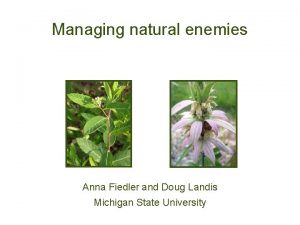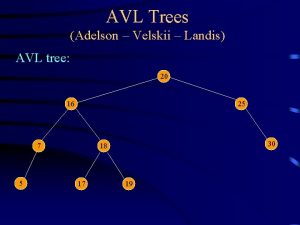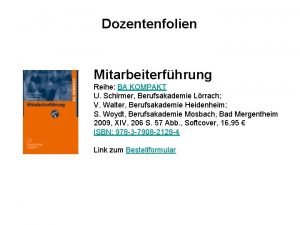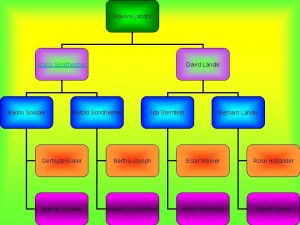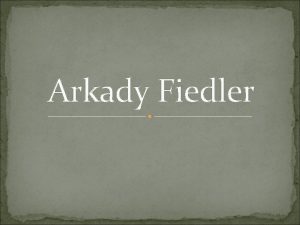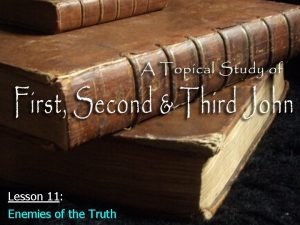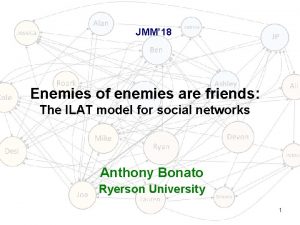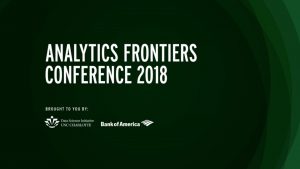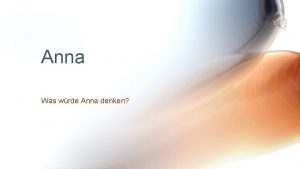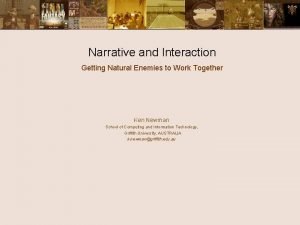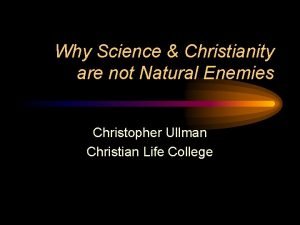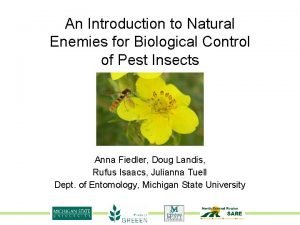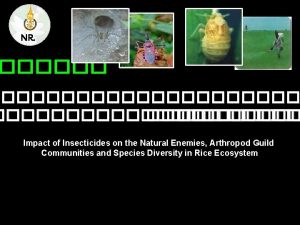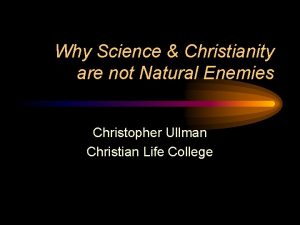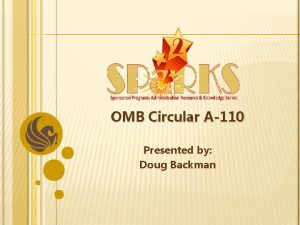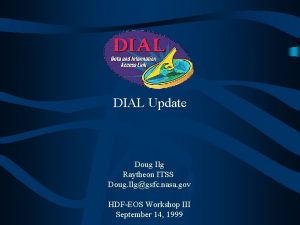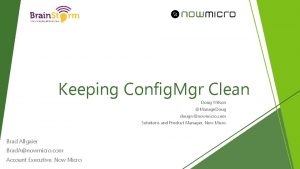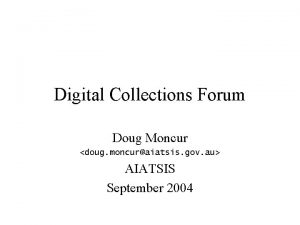Managing natural enemies Anna Fiedler and Doug Landis




























- Slides: 28

Managing natural enemies Anna Fiedler and Doug Landis Michigan State University

Ecosystem Services Pollination Decomposition Biological Control

Biological Control Use of natural enemies to keep unwanted pest populations low

Three types of Natural Enemies • Predators: eat many prey in a lifetime, feeding both as young and as adults. • Parasitoids: specialized insects that develop as a young in one host, eventually killing it. • Pathogens: nematodes, viruses, bacteria, fungi, protozoans.

Types of Biological Control • Classical: introduction of nonnative natural enemy to control a pest population. • Augmentative: periodically increase natural enemy population with an artificially reared release. • Conservation: maintain or enhance existing natural enemy populations.

What do beneficial insects need? Alternate host/prey Shelter Moderated microclimates In-season refuges Overwintering sites Food Nectar Pollen Sap, honeydew

Historical Landscapes Prairie Diverse habitats provide - Biodiversity - Pest suppression - Pollination Oak savanna

Native Plant Project Goals Use native plants to provide beneficial insects with nectar and pollen. Decrease pesticide use and increase pollination.

Exotic Plants Benefits – Reliable seed or plant sources – Prolific floral display – Previous success in other locations Disadvantages – Do not enhance native biodiversity – May be invasive alyssum phacelia buckwheat coriander

Native Plants Benefits –Enhance native biodiversity –Re-creation of imperiled habitats –Less likely to be invasive –Adapted to local climate –Habitat permanency Disadvantages –Greater initial cost –Longer establishment time




Natural Enemies Collected at Flowers 25% 2005 data 30%

Incorporating native plants on your farm • Use local native plants. • Choose several colors of flowers. • Plant flowers in clumps. • Select flowers to provide bloom through the season. • More flower area = more beneficial insects! • Include native grasses for structural support

Beneficial Insect Friendly Practices • Provide nesting and overwintering resources. • Avoid insecticide use. • Provide flowers through growing season.

Native Plants in the Landscape

Establishing native plants Select a site Analyze the site Consider planting options Size of area Time to flowering Cost Plan and design the planting Plant Maintenance Short term Long term

Select a Site

Analyze the site Consider Light availability Soil type Soil moisture Soil p. H

Select Plant species Suited to conditions Variety of bloom periods Include wildflowers and grasses Local seed or plant source Seed vs. plant material Michigan Wildflower Farm

Site Preparation Yard – Treat with roundup fall or mid-spring – Smother 2 -3 months when growing Typical ag field – 1 year fallow – Repeated light tillings Weedy site (old field) – Burn or plow – 1 year fallow

Plant or Seed

Plant or Seed

Maintenance Weed your native planting OR 1) Mow a seeding 2 -4 times in year one 1 -2 times in year two 2) Burn or mow annually

Learn More Native Plants to Enhance Beneficial Insects website E-2985 www. nativeplants. msu. edu E-2973 E-2949

Learn More Contact a native plant producer: Acorus Native Plant Nursery www. ecologyart. com Native Plant Source www. nativeplantsource. com – may not be local seed

Acknowledgements Research collaborators Bill Schneider, Wildtype Native Plant Nursery Esther Durnwald, MI Wildflower Farm Jerry Stewart, Native Connections Gene Vogel, Richard Stuckey Rufus Isaacs, Julianna Tuell USDA NRCS Ingham County Soil Conservation District MSU IPM Funding Support USDA Sustainable Agriculture Special Grant Identification support Gary Parsons Dr. Debra Trock Undergraduate research assistants Jessica Steffen Dawn Richards Emily Knoblock www. nativeplants. msu. edu
 Doug landis
Doug landis Adelson-velsky and landis
Adelson-velsky and landis Landis walsh
Landis walsh Vezetői rács
Vezetői rács Ohio state university modell
Ohio state university modell Fiedler vector
Fiedler vector Brad fiedler
Brad fiedler Glacehandschuh management
Glacehandschuh management Arkady fiedler ciekawostki
Arkady fiedler ciekawostki Myocarditis
Myocarditis Fiedler liderlik modeli
Fiedler liderlik modeli Arkady fiedler ciekawostki
Arkady fiedler ciekawostki 1985
1985 Fiedler auf dem dach
Fiedler auf dem dach Massimiliano pellegrini
Massimiliano pellegrini Summarize the conclusions of trait theories of leadership.
Summarize the conclusions of trait theories of leadership. Path goal theory of leadership
Path goal theory of leadership Kresz & fiedler kft
Kresz & fiedler kft Multidimensional model of sport leadership
Multidimensional model of sport leadership Caracteristicas de la teoria de la contingencia
Caracteristicas de la teoria de la contingencia Shrek meeting the mentor
Shrek meeting the mentor Romans 1:24-32
Romans 1:24-32 Cindy mele
Cindy mele Enemies of good credit
Enemies of good credit Love your enemies essay
Love your enemies essay Batmans enemies
Batmans enemies Assyrian archers pursuing enemies
Assyrian archers pursuing enemies Characteristics of enemies of the cross
Characteristics of enemies of the cross Humayun class 7
Humayun class 7
